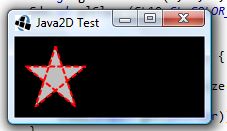-
Notifications
You must be signed in to change notification settings - Fork 184
LibGDX & Java2D
Complex polygons, strokes, dotted outlines, and various other raster effects are difficult to achieve in OpenGL. Solutions such as GL_LINES may lead to different visual results across platforms, while other options have been deprecated altogether (e.g. glLineStipple).
If you are only targeting desktop, you may decide to use Java2D for rasterization. It's a powerful, flexible and easy to use API that leads to implementation-independent rendering. In order to use Java2D's rasterizer in LibGDX, we need to render it to a Java2D BufferedImage, then copy the pixels to a texture on the GPU.

For better performance you would minimize the number of times you upload data to GL; e.g. accumulating the data into the same glTexSubImage2D call. Also, you could modify the below code to upload to a texture atlas, rather than having a single large texture per shape.
This is not an ideal solution for dynamic shapes that need to change frequently, but for static shapes it may lead to crisper graphics than GL_LINES or meshes.
import java.awt.BasicStroke;
import java.awt.Color;
import java.awt.Graphics2D;
import java.awt.Rectangle;
import java.awt.RenderingHints;
import java.awt.geom.GeneralPath;
import java.awt.image.BufferedImage;
import java.awt.image.DataBufferInt;
import java.nio.IntBuffer;
import java.util.ArrayList;
import java.util.List;
import org.lwjgl.opengl.GL12;
import com.badlogic.gdx.Application.ApplicationType;
import com.badlogic.gdx.ApplicationListener;
import com.badlogic.gdx.Gdx;
import com.badlogic.gdx.backends.lwjgl.LwjglApplication;
import com.badlogic.gdx.backends.lwjgl.LwjglApplicationConfiguration;
import com.badlogic.gdx.graphics.GL10;
import com.badlogic.gdx.graphics.GL11;
import com.badlogic.gdx.graphics.OrthographicCamera;
import com.badlogic.gdx.graphics.Pixmap.Format;
import com.badlogic.gdx.graphics.Texture;
import com.badlogic.gdx.graphics.g2d.SpriteBatch;
import com.badlogic.gdx.graphics.g2d.TextureRegion;
import com.badlogic.gdx.utils.BufferUtils;
import com.badlogic.gdx.utils.GdxRuntimeException;
public class Java2DTest implements ApplicationListener {
public static void main(String[] args) {
LwjglApplicationConfiguration cfg = new LwjglApplicationConfiguration();
cfg.title = "Java2DTest";
cfg.useGL20 = false;
cfg.width = 480;
cfg.height = 320;
new LwjglApplication(new Java2DTest(), cfg);
}
private OrthographicCamera camera;
private SpriteBatch batch;
private Java2DTexture j2dTex;
private TextureRegion sprite;
private List<java.awt.Shape> shapes = new ArrayList<java.awt.Shape>();
private int pointer = 0;
@Override
public void create() {
if (Gdx.app.getType()!=ApplicationType.Desktop)
throw new GdxRuntimeException("this demo only works on desktop with Java2D");
float w = Gdx.graphics.getWidth();
float h = Gdx.graphics.getHeight();
camera = new OrthographicCamera(w, h);
camera.setToOrtho(false);
batch = new SpriteBatch();
// 1. -- create our Java2D buffer; must be big enough to hold our shape!
j2dTex = new Java2DTexture(1024, 1024);
// 2. -- setup our texture region for drawing part of our buffer
sprite = new TextureRegion(j2dTex);
// 3. --- Setup a few shapes for example
GeneralPath path = new GeneralPath();
path.moveTo(50, 120);
path.lineTo(70, 180);
path.lineTo(20, 140);
path.lineTo(80, 140);
path.lineTo(30, 180);
path.closePath();
shapes.add(path);
path = new GeneralPath();
path.moveTo(120, 180);
path.quadTo(150, 120, 180, 180);
path.closePath();
shapes.add(path);
path = new GeneralPath();
path.moveTo(220, 150);
path.curveTo(240, 130, 280, 160, 300, 140);
path.lineTo(300, 180);
path.quadTo(260, 160, 220, 180);
path.closePath();
shapes.add(path);
path = new GeneralPath();
path.moveTo(360, 100);
path.lineTo(360, 200);
path.lineTo(400, 140);
path.lineTo(320, 120);
path.lineTo(400, 180);
path.lineTo(320, 180);
path.closePath();
shapes.add(path);
// 4. show a shape..
show(shapes.get(pointer));
}
void show(java.awt.Shape shape) {
Graphics2D g2d = j2dTex.begin();
//do whatever want here, e.g. solid fill, strokes, gradient fill
g2d.setColor(Color.lightGray);
g2d.fill(shape);
//draw a dashed stroke...
g2d.setColor(Color.red);
g2d.setStroke(new BasicStroke(2, BasicStroke.CAP_ROUND,
BasicStroke.JOIN_ROUND,
10, new float[] { 4, 4 }, 0));
g2d.draw(shape);
//upload data to GL
j2dTex.end();
//don't forget to set our texture region up..
//we use + 1 since Java2D draws outlines on the OUTSIDE
Rectangle bounds = shape.getBounds();
sprite.setRegion(bounds.x, bounds.y, bounds.width+1, bounds.height+1);
}
@Override
public void dispose() {
batch.dispose();
j2dTex.dispose();
}
@Override
public void render() {
Gdx.gl.glClearColor(0, 0, 0, 0);
Gdx.gl.glClear(GL10.GL_COLOR_BUFFER_BIT);
//show next shape
if (Gdx.input.isTouched()) {
pointer++;
if (pointer>=shapes.size())
pointer = 0;
show(shapes.get(pointer));
}
batch.setProjectionMatrix(camera.combined);
batch.begin();
batch.draw(sprite, 10, 10);
batch.end();
}
@Override
public void resize(int width, int height) {
camera.setToOrtho(false, width, height);
}
@Override
public void pause() {
}
@Override
public void resume() {
}
public static class Java2DTexture extends Texture {
protected BufferedImage bufferImg;
protected IntBuffer buffer;
private final Color BACKGROUND = new Color(0, 0, 0, 0);
public Java2DTexture(int width, int height, Format format) {
super(width, height, format);
bufferImg = new BufferedImage(width, height, BufferedImage.TYPE_INT_ARGB);
buffer = BufferUtils.newIntBuffer(width * height);
}
public Java2DTexture(int width, int height) {
this(width, height, Format.RGBA8888);
}
public Java2DTexture() {
this(1024, 1024);
}
public BufferedImage getBufferedImage() {
return bufferImg;
}
public Graphics2D begin() {
//you could probably cache this instead of requesting it every time
Graphics2D g2d = (Graphics2D) bufferImg.getGraphics();
g2d.setRenderingHint(RenderingHints.KEY_ANTIALIASING,
RenderingHints.VALUE_ANTIALIAS_ON);
g2d.setBackground(BACKGROUND);
g2d.clearRect(0, 0, bufferImg.getWidth(), bufferImg.getHeight());
g2d.setColor(java.awt.Color.white);
return g2d;
}
public void end() {
// now we pass the BufferedImage pixel data to the LibGDX texture...
int width = bufferImg.getWidth();
int height = bufferImg.getHeight();
//you could probably cache this rather than requesting it every upload
int[] pixels = ((DataBufferInt)bufferImg.getRaster().getDataBuffer())
.getData();
this.bind();
buffer.rewind();
buffer.put(pixels);
buffer.flip();
Gdx.gl.glTexSubImage2D(GL11.GL_TEXTURE_2D, 0, 0, 0, width, height,
GL12.GL_BGRA, GL12.GL_UNSIGNED_INT_8_8_8_8_REV, buffer);
}
}
}